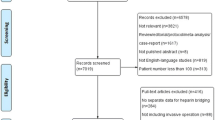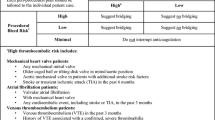Abstract
Background: Over 2 million patients in North America are on warfarin anticoagulation therapy for prevention of thromboembolism. Suspension of warfarin therapy is often required to prepare patients for invasive procedures or surgeries. To protect these patients against thromboembolism while they are off warfarin, shorter-acting parenteral agents such as low-molecular-weight heparins (LMWHs) are often used. We conducted a retrospective observational study of our anticoagulation clinic patients to assess the safety and efficacy of LMWHs using a standardized protocol for periprocedural anticoagulation therapy.
Methods: We included 69 consecutive patients who required interruption of their long-term warfarin therapy between August 2001 and August 2002, and were deemed by the treating physician to be at high enough risk for perioperative thromboembolism to justify bridging anticoagulation. We used a standard bridging therapy protocol in our anticoagulation clinic. Sixty-six patients received enoxaparin and three patients received tinzaparin for a mean duration of 7.7 days postoperatively. Outcomes were assessed for 30 days post-procedure. Safety outcomes included major bleeding and minor bleeding. Efficacy outcomes included thromboembolic event or death.
Results: There were two major bleeding events, one minor bleeding event, and no cases of thromboembolism. Twelve patients experienced some bruising around the injection site.
Conclusions: LMWH administration using our standard outpatient bridging protocol for perioperative anticoagulation appears to be relatively safe and efficacious, offering an alternative to inpatient administration of intravenous unfractionated heparin (UFH). Our study provides additional evidence to the limited published observational data regarding the safety and efficacy of LMWH as bridging therapy in the perioperative and periprocedural setting. Large, multicenter, randomized controlled trials are necessary to fully assess the safety and efficacy of LMWH for perioperative anticoagulation.
Abbreviated Abstract
We conducted a retrospective observational study of 69 consecutive anticoagulation clinic patients on warfarin between August 2001 and August 2002, who were undergoing a procedure or surgery. The study was done to assess the safety and efficacy of an outpatient LMWH bridging protocol. Sixty-six patients received enoxaparin and three patients received tinzaparin for a mean duration of 3 days preoperatively and 7.7 days postoperatively. Outcomes were assessed for 30 days post-procedure. Safety outcomes included major bleeding and minor bleeding. Efficacy outcomes included thromboembolic event or death. There were two major bleeding events, one minor bleeding event, and no cases of thromboembolism. Twelve patients experienced some bruising around the injection site.
Similar content being viewed by others
References
Waterman AD, Banet G, Milligan PE, et al. Patient and physician satisfaction with a telephone-based anticoagulation service. Journal of General Internal Medicine 2001;16(7):460–463.
White RH, McKittrick T, Hutchinson R, Twitchell J. Temporary discontinuation of warfarin therapy: Changes in the international normalized ratio. Ann Intern Med 1995;122(1):40–42.
De Groot MR NT, Van Marwijk et al. Abrupt versus gradual withdrawal of Vitamin K antagonist treatment in patients with venous thromboembolic disease: Assessment of hypercoagulability and clinical outcome. Clinical laboratory 2000;46(11/12):575–581.
Palareti G, Legnani C. Warfarin withdrawal. Pharmacokinetic-pharmacodynamic considerations. Clin Pharmacokinet 1996;30(4):300–313.
Palareti G, Legnani C, Guazzaloca G, et al. Activation of blood coagulation after abrupt or stepwise withdrawal of oral anticoagulants–-a prospective study. Thromb Haemost 1994;72(2):222–226.
Ansell JE. The perioperative management of warfarin therapy. Arch Intern Med 2003;163(8):881–883.
Douketis JD, Johnson JA, Turpie AG. Low-molecular-weight heparin as bridging anticoagulation during interruption of warfarin: Assessment of a standardized periprocedural anticoagulation regimen. Arch Intern Med Jun 28 2004;164(12):1319–1326.
Ferreira IJ DL, Tornos et al. Is low molecular weight heparin a safe alternative to unfractionated heparin in patients with prosthetic mechanical heart valves who must interrupt antithrombotic therapy[abstract]. Eur Heart J 2000;21:301.
Galla JM FB. Outpatient anticoagulation protocol for mechanical valve recipients undergoing non-cardiac surgery [abstract]. J Am Coll Cardiol 2000;135:531A.
Lev-Ran O, Kramer A, Gurevitch J, Shapira I, Mohr R. Low-molecular-weight heparin for prosthetic heart valves: Treatment failure. Ann Thorac Surg 2000;69(1):264–265; Discussion 265–266.
Spandorfer J. The management of anticoagulation before and after procedures. Medical Clinics of North America 2001;85(5):1109–1116.
System UH. Home LMWH bridge therapy in cardiac valve replacement: Safe, effective and cost saving. Formulary 2000;35:990–991.
Tinmouth AH, Morrow BH, Cruickshank MK, Moore PM, Kovacs MJ. Dalteparin as periprocedure anticoagulation for patients on warfarin and at high risk of thrombosis. Ann Pharmacother 2001;35(6):669–674.
Pasternak LR. Preanesthesia Evaluation of the Surgical Patient. Paper presented at: ASA; 1996.
Kovacs MJ, Kearon C, Rodger M, et al. Single-arm study of bridging therapy with low-molecular-weight heparin for patients at risk of arterial embolism who require temporary interruption of warfarin. Circulation Sep 21 2004;110(12):1658–1663.
Author information
Authors and Affiliations
Corresponding author
Rights and permissions
About this article
Cite this article
Jaffer, A.K., Ahmed, M., Brotman, D.J. et al. Low–Molecular-Weight-Heparins as Periprocedural Anticoagulation for Patients on Long-Term Warfarin Therapy: A Standardized Bridging Therapy Protocol. J Thromb Thrombolysis 20, 11–16 (2005). https://doi.org/10.1007/s11239-005-3120-9
Issue Date:
DOI: https://doi.org/10.1007/s11239-005-3120-9




